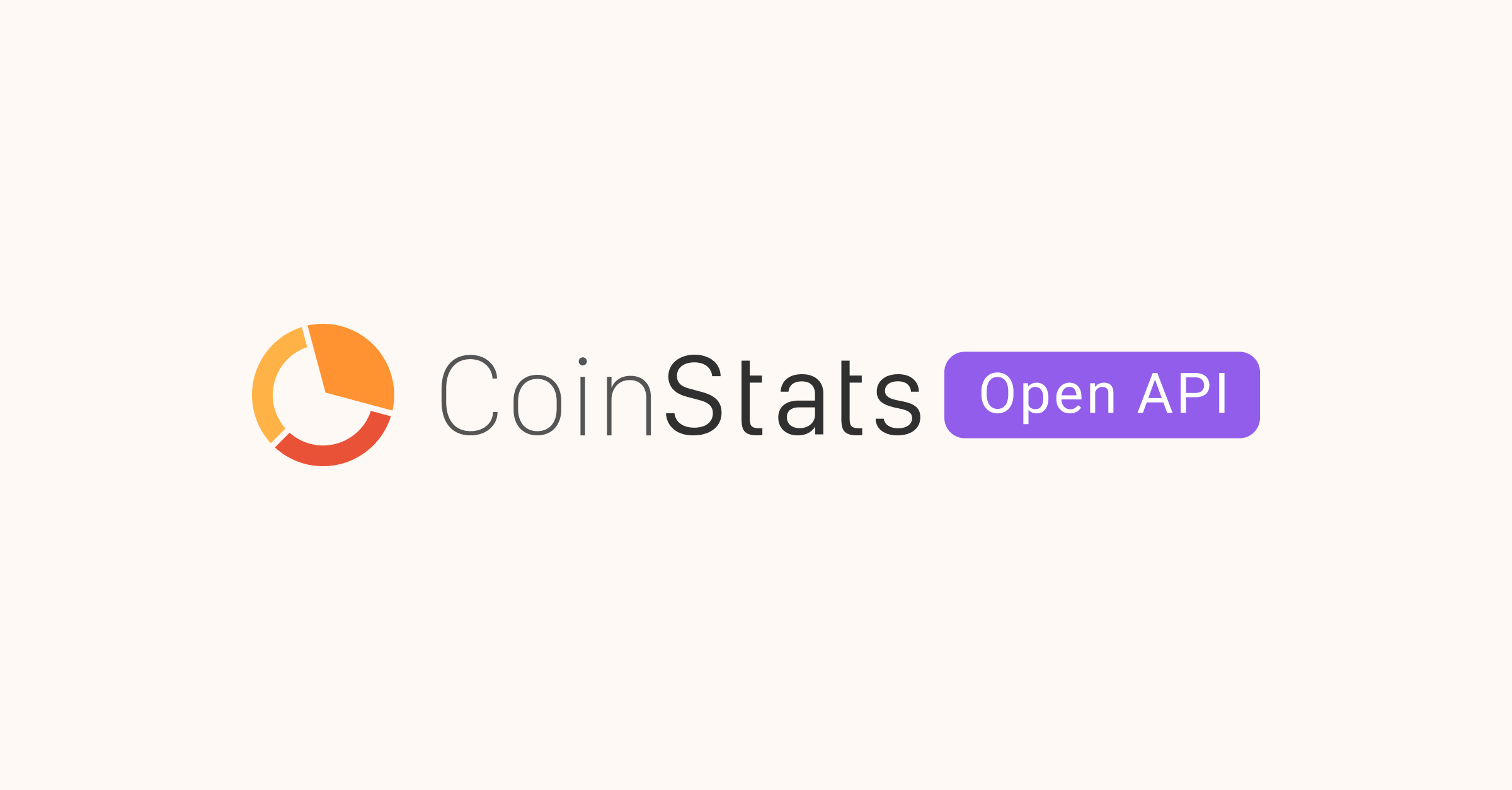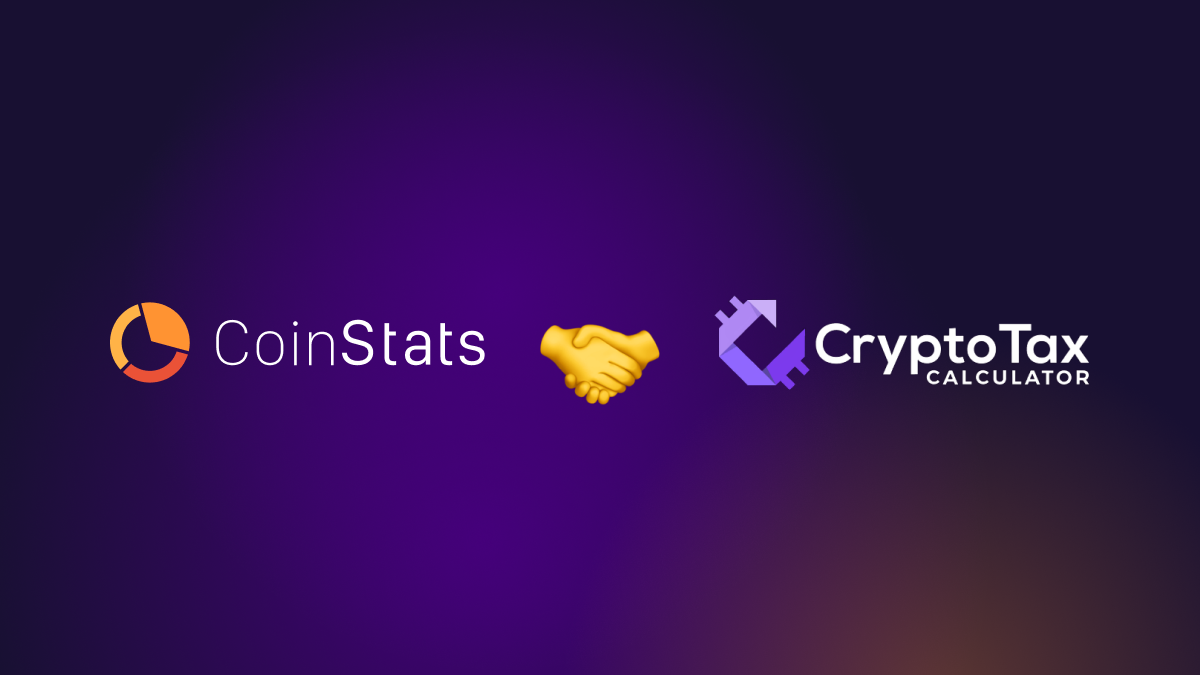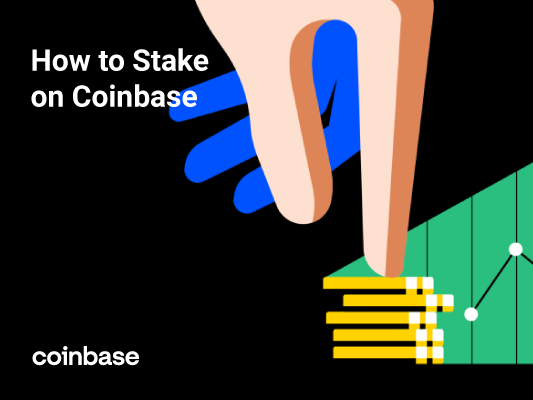
How to Stake on Coinbase [The Ultimate 2023]
Millions of investors worldwide enjoy the income created through staking rewards, an income paid to crypto owners who help regulate and validate a cryptocurrency’s transactions. Many DeFi protocols offer great incentives for those who stake cryptocurrency tokens and lock them into risky smart contracts by offering interest on investment and governance tokens.
To earn rewards, you have to participate in staking. The Coinbase staking reward system for eligible cryptocurrency lets you accumulate more coins as the Coinbase algorithm optimizes staking opportunities.
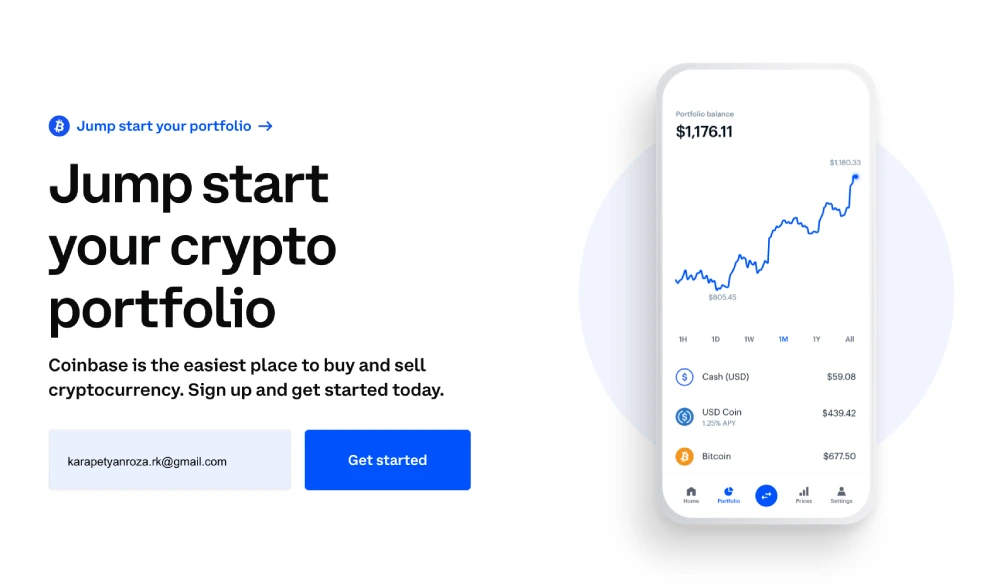
Read on to learn how to stake on the Coinbase exchange to increase your staking rewards significantly, choose the safest crypto assets, and more.
Let’s get started!
Consensus Mechanism
In a centralized system, like a DMV database, a central authority controls all the possible data and updates and is in charge of maintaining genuine records.
Conversely, decentralized systems, for example, blockchain networks, work without any single authority. Public blockchains operate as self-regulating systems by involving contributions from millions of participants globally who verify and authenticate transactions occurring on the blockchain. To ensure that all the transactions occurring on the network are genuine and that all participants agree on a consensus on the status of the ledger, these publicly shared ledgers need an efficient, fair, real-time, functional, reliable, and secure mechanism.
The mechanism that performs this important task is the consensus mechanism, which refers to a set of rules used to achieve agreement, trust, and security across a decentralized computer network.
Proof-of-Work (PoW) and Proof-of-Stake (PoS) are two of the most prevalent consensus mechanism algorithms, each of which works on different principles.
Proof-of-Work (PoW)
PoW is a common consensus algorithm that requires a participant node to prove that the work done and submitted by them qualifies them to receive the right to add new transactions to the blockchain. PoW is used by the most popular cryptocurrency network like Bitcoin. However, Bitcoin’s mining mechanism requires high energy consumption and a longer processing time, which raised a lot of controversy against it.
Proof-of-Stake (PoS)
PoS is a low-energy consuming alternative to the PoW algorithm, in which staking is used to validate transactions. It involves allocating responsibility in maintaining the public ledger to a participant node in proportion to the number of virtual currency tokens it holds.
In short, anyone holding a required number of coins can earn staking rewards and participate in validation, i.e., verify transactions as needed. As a result, crypto holders often choose to stake coins in the hope of earning interest instead of trading them.
How Does Staking Work
Staking is only applicable to blockchains that utilize the PoS consensus mechanism. Those who stake their crypto in a PoS blockchain are called validators. Validators provide value to the network by locking assets for an agreed-upon ‘staking period’ and earn rewards in return. PoS validators are selected based on the higher number of staked coins.
Staking pools
Individuals can start staking if they have enough assets needed to become a validator on the blockchain network. However, they can use staking pools if they want to participate in the staking activity without having to stake large amounts of a crypto token. A staking pool is a tool allowing stakeholders to pool in their tokens to give the staking pool operator a validator status and earn staking rewards for their computational resources’ contributions.
For example, staking on the Ethereum Network requires 32 ETH tokens, which equals approximately $40,000 and might be challenging for the average investor.
Mining Vs. Staking
The main difference between mining and staking is the underlying consensus mechanism used to validate transactions. Mining is used for PoW, and staking is used primarily for PoS.
Here are some of the differences between mining and staking:
| MINING | STAKING |
| Miners solve complicated mathematical puzzles. | Certain nodes validate new blocks by locking up their funds. |
| The first miner to solve the puzzle gets to add a new block to the chain. | Nodes validate a new block by locking up native tokens in a smart contract. |
| Mining requires specialized equipment, using up a lot of energy. | Staking requires fractions of PoW energy, saving 99% of energy consumption, according to Vitalik Buterin. |
| More work (computational power) equals a higher chance of getting rewarded. | More tokens staked equals a higher chance of getting selected to validate new blocks and earning rewards. |
How to Choose a Staking Platform
Staking rewards might promise easy money, but any trader should take extra care before choosing a staking platform. Making the wrong choice could result in losing staking rewards and, in some cases, the staked crypto as well. So here are some points to consider while making the decision:
- Do Your Own Research
Take the time to do proper research before trusting your funds to a staking platform. Scammers are not uncommon, so never take the founder’s word as the only basis for your decision. - Understand How Crypto Staking Works on Each Platform
Read the platform’s terms and conditions carefully. Many issues are easy to overlook, such as: Is the wallet available without internet access? What is the minimal staking amount? Does the staked crypto have to go through a cooling period before it can be unstaked? - Don’t Chase the Highest APY
High returns don’t equal safety. Take your time to choose a platform you can trust based on its experience, reputation, users’ reviews, and the possibilities to earn interest. Be careful and don’t chase the highest possible annual percentage yields or rewards without considering other factors.
We hope this Coinbase review by CoinStats might help you make an informed decision. You can also learn how to benefit from the system with articles like What Is DeFi.
Coinbase Staking
Coinbase is a secure, centralized platform for staking crypto that has been around for a decade. Coinbase features a mobile app, making staking on the go more convenient. However, business accounts are not eligible for earning rewards on Coinbase.
Let’s take a closer look at Coinbase staking and the rewards and tokens available for traders wishing to stake crypto.
How Coinbase Staking Works?
First and foremost, you should create a Coinbase account to stake on Coinbase. The process is straightforward, and it takes a few mouse clicks and basic info to get started.
While going through a KYC (Know Your Customer) verification process is not mandatory for all users, Coinbase requires KYC verification for crypto staking.
Here is a short step-by-step guide to make things easier:
- Create a Coinbase account.
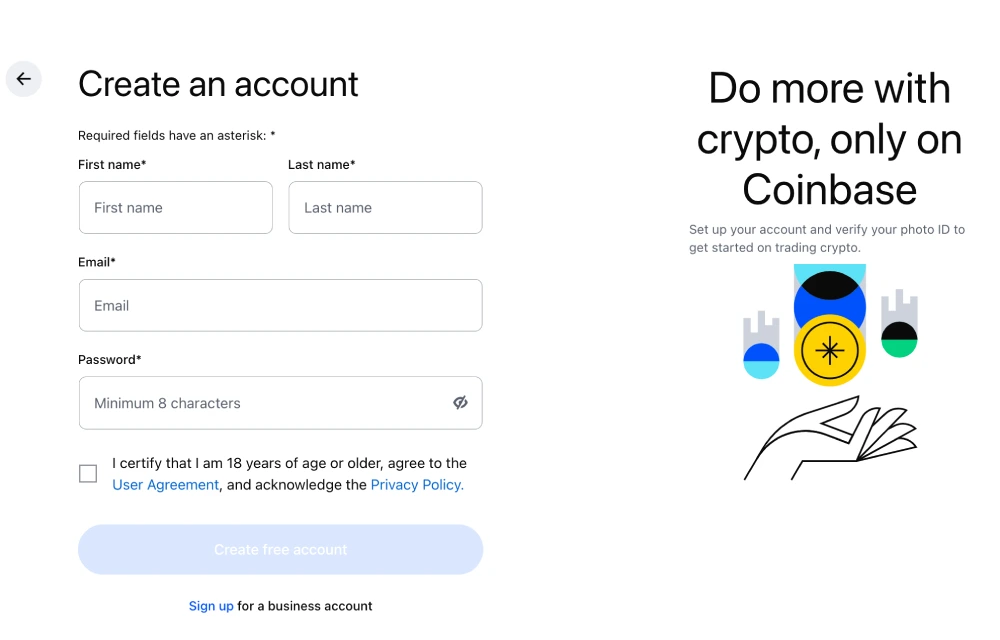
- Purchase major cryptos like Bitcoin (BTC) or Ethereum (ETH) using your bank account.
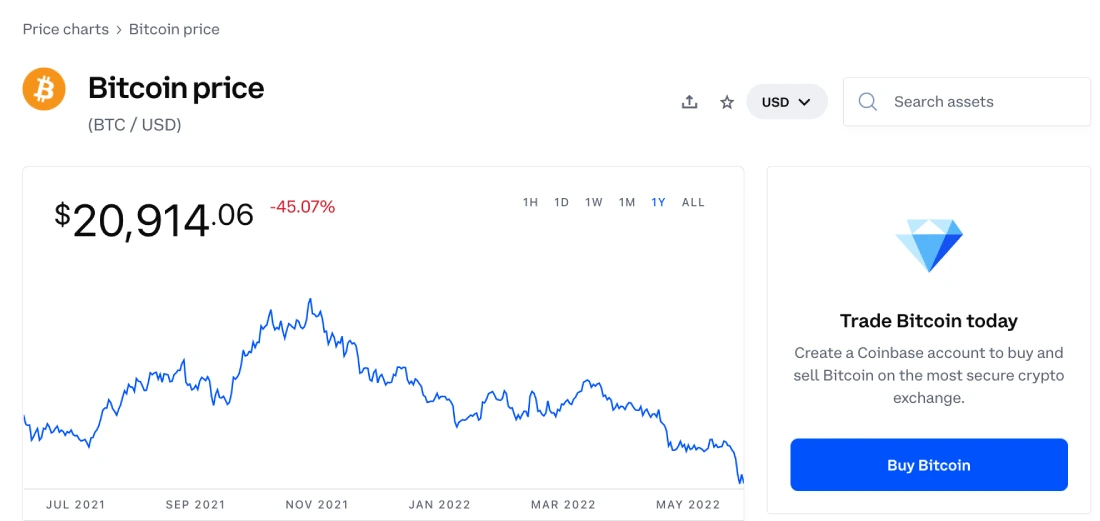
- Swap the BTC or ETH for the crypto you want to stake on Coinbase.
- Stake your tokens and earn rewards.
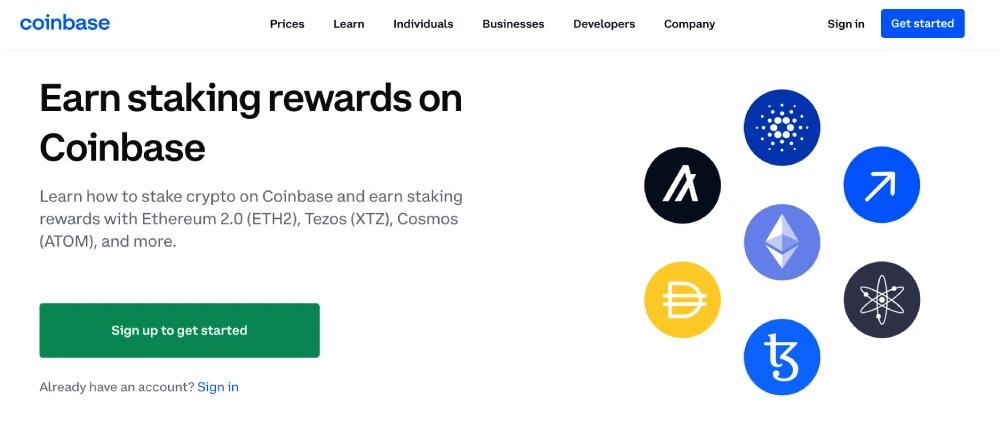
Read on to learn more about the specific rewards and distribution schedules each token has to offer. Additionally, Coinbase suggests bearing in mind a few essentials.
Essentials to Keep In Mind
- You might need to agree on specific terms and conditions to start staking some tokens. Read those conditions carefully.
- Users maintain full ownership of their staked crypto; however, Coinbase “may or may not” replace the staked ETH tokens, i.e., ETH2, in case of a slashing incident. The platform provides additional information on the matter.
- Coinbase retains the right to withhold a small amount of certain assets with “lockups at the protocol level.” The precaution is to ensure a user has liquidity and can cash out the crypto as needed.
- The platform charges a commission on all staking rewards. So, before staking cryptocurrency, make sure you read the User Agreement carefully, as it specifies all the possible fees and commissions beforehand.
Eligibility For Staking Rewards
Here are the main requirements for staking crypto on Coinbase:
- KYC verification: Each needs to have their identity verified.
- A minimal balance is customized for each crypto.
- The minimal balance can either be maintained on Coinbase or transferred from another wallet.
- Rewards are not available on Coinbase Pro, as opposed to Coinbase.com.
Tokens Available for Coinbase Staking
Currently, crypto investors stake Algorand (ALGO), Cosmos (ATOM), Ethereum (ETH), Tezos (TXZ), and Cardano (ADA) on Coinbase.
| Cryptocurrency | Minimum Balance Needed | Rewards Payout Rate |
| Algorand (ALGO) | 0.01 ALGO | Quarterly |
| Cosmos (ATOM) | 0.0001 ATOM | 7 days |
| Ethereum (ETH) | No minimum balance | Daily |
| Tezos (XTZ) | 0.0001 XTZ | 3 days |
| Cardano (ADA) | $1 worth of ADA | 5 days |
Rewards for Each Eligible Token
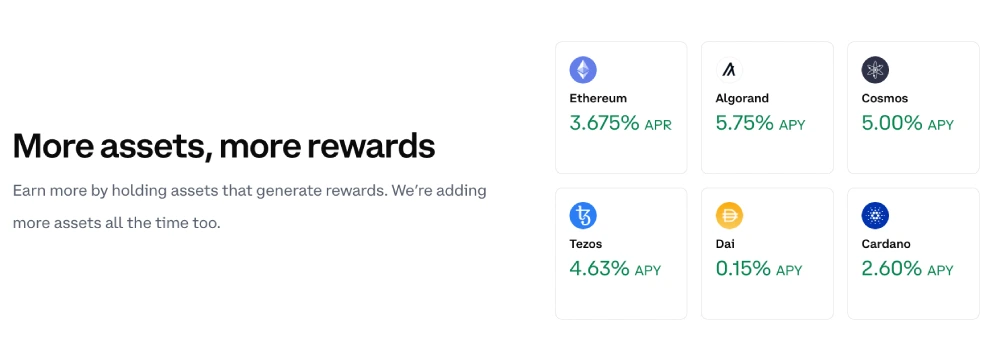
- Algorand (ALGO) shifted to a new reward model in 2022, which distributes the appropriate rewards quarterly or every 3 months instead of a daily system.
- Cosmos (ATOM) distributes the first payment within 7-14 days and every consecutive reward within 7 days.
- Ethereum (ETH) will credit the first reward after 14 days and daily reward snapshots afterward.
NOTE: Ethereum Network has yet to transition to Proof-of-Stake fully; therefore, Coinbase issues the following warning on ETH staking:
“ETH2 staking rewards will be reflected in your account under Lifetime Rewards and will be updated regularly. At this time, staking rewards won’t be added to your overall staking balance, and you won’t be able to access them.” - Tezos (XTZ) takes approximately 35-40 days to issue the initial reward for staking XTZ and 3 days for every consecutive reward.
- Cardano (ADA) takes 20 days to issue the initial reward and 5 days for each consecutive reward.
The list of assets might change as the platform grows. All the changes are typically reflected on the Coinbase website and Coinbase mobile app.
Risks and Rewards of Crypto Staking
While staking cryptocurrencies is a rewarding endeavor, each trader should be fully aware of the risks it poses on any platform. So let’s talk more about the advantages and disadvantages involved in staking.
Rewards

- Passive income generation
There’s nothing wrong with storing your crypto, hoping for price appreciation. Also, swapping one crypto for another is a no-brainer if you feel the alternative would serve you better. However, staking generates more rewards than the usual price appreciation. - Easy and quick
Staking is a quick and straightforward process. The starting amount can also be relatively small if a trader enters a staking pool instead of being a sole validator.
Risks
- Crypto prices are highly volatile, and price fluctuations could lead to a loss of funds. Use crypto portfolio trackers to keep up with the changing prices.
- The smaller the coin, the higher the volatility. This is why some smaller cryptos offer higher APYs. In other words, you adopt a high-risk/high-reward strategy while staking smaller cryptocurrencies that might not be acceptable for all traders.
- The staking process requires locking your funds for a certain period. If the asset depreciates during this time, you won’t be able to repair the damage.
Frequently Asked Questions
Can I trade or send tokens while they’re passively earning rewards?
Cashing out should be an option in case of crypto staking. However, it might be subject to several factors, including your general transaction history, account history, and banking history.
Occasionally, cash-outs and trades may be delayed while investors wait for Coinbase to unlock the funds in question. If the delay continues, each trader will get a notification on Coinbase.com and via the app or email.
Can I earn rewards while using a Coinbase vault?
Yes, storing funds in a Coinbase vault can earn you rewards. However, that’s only the case if the crypto in question is eligible for rewards. Read above for a complete list of tokens available for staking on Coinbase.
Note: Storing ETH2 or ADA in a vault will NOT earn rewards at the moment.
Does the estimated reward equal the actual payout?
Your Coinbase account reflects an estimate of a possible reward based on the network’s description. However, the network’s actual distribution might differ from the estimate. The estimation is based on Coinbase’s prior staking performance for that cryptocurrency.
Will the reward rate be constant?
The reward rate can fluctuate depending on various factors primarily set by the protocol. Other factors influencing the rate include validator performance, amount of staking, inflation of savings rates, etc.
Are rewards guaranteed?
The Coinbase platform does not guarantee any staking rewards to any individual customer over time.
Are rewards from staking considered a taxable event?
Coinbase is subject to U.S. taxation laws, so U.S. customers, subject to U.S. tax reporting, must report their earnings from staking rewards. The Internal Revenue Service’s 1099-MISC is eligible for rewards over $600.
What is the Annual Percentage Yield, and how is it calculated?
Annual Percentage Yield (APY) is the percentage you get on top of the account as a reward for staking your funds, calculated annually. Also, the APY is a projection based on historically relevant calculations. Coinbase specifies that this rate is “set by the applicable asset protocol,” and Coinbase itself does not set, control, or influence it in any way.
Each network employs its own reward system and its own APY. However, as mentioned, Coinbase charges a commission on each transaction. All the details can be found in the user agreement.
Conclusion
Hopefully, by now, you have the answer to the question: How to stake on Coinbase? Staking is easy, but it carries substantial risks to consider. Even on the safest platform in the market, staking can still result in a loss of funds due to a token’s price depreciation.
However, amazing rewards are offered for staking the five tokens available on Coinbase.


